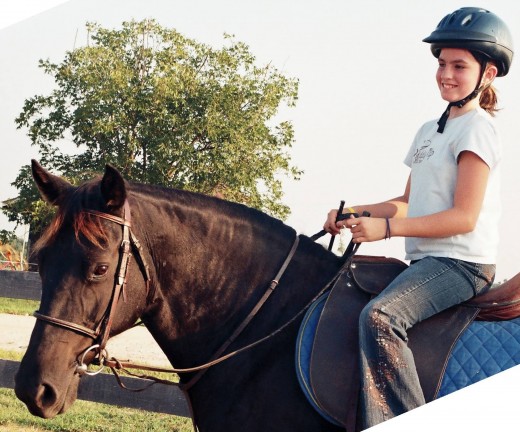Gaited Horses in the Lesson String
"But, you can't use gaited horses for lessons, they don't trot," a lady admonished me when she learned I have three Tennessee Walking Horses in my lesson string.
I thought my students were learning to ride just fine on my non-trotting horses, but her comment made me wonder if I was the only instructor teaching balanced seat and equitation on horses that don't normally trot.
I started emailing and asking my peers in the lesson giving business. I learned while instructors have differing opinions, most agree the gaited horse can certainly be used to teach basic horsemanship successfully, and in certain situations can even be a better choice over the trotter.

The Only Thing Lacking is the Trot
Only one thing is found lacking in the gaited horse-the trot. People who ride these smoothies will probably tell you that is a good thing. But if its trot you want, some gaited horses can be persuaded to travel that bouncy two-beat gait.
To answer the question of whether a gaited horse is suitable for a lesson mount we should review what the instructor looks for in a good school horse. Good disposition (which includes tolerance of the student's mistakes), soundness, responsiveness to the aids and the athletic ability to perform at the level of lessons being taught are the basic requirements of a school horse. None of those traits are breed specific, or even gait specific. Only when the student advances to showing in a particular discipline does he or she have to make a choice between trotting and non-trotting horses.
Liz Graves, author, horse show judge and teacher has conducted over one hundred All Breed Gaited Horse Clinics in the US and Canada. She says, "Yes," to the question of using the gaited lesson horse, "Gaited horses are a wonderful mount in teaching programs."
Liz uses both gaited and none gaited horses in her program, but she finds teaching basic balance without the excessive movement of a trot is an advantage of the smooth gaited horses.
"Once a good knowledge of total body use and balance is achieved then I mount them up on a none gaited breed."
Referring to the gaited horse, Liz says, "First and foremost though, they still are a horse before a breed and all the basics of leg, hand and seat aids apply the same as well as learning equine physiology, and handling from ground to riding."
"There are also variations of smooth in all the gaits," Liz explains. She says riding a variety of horses with different gaits help teach the rider how the gaits effect their body when riding. "Folks become more aware of there own bodies in using gaited horses and learning what each gait is." She goes on to say, "I see no limitations using gaited horses. I have used gaited horses for jumping for many years as well as cattle work and driving."
To be fair not everyone who answered my query felt that gaited horses would work in their program. Beth Thomas of Johnstown, Pennsylvania teaches hunter seat and jumping at Stone Hollow, and like several other hunt seat trainers she doesn't have a place for gaited horses in her program.
She says, "I don't use or want gaited horses in my lesson program because they usually don't trot. I have nothing against them but I teach hunt seat and I need horses that trot well and can canter down to jumps. I do realize there are a lot of gaited horses that can jump but that is more exception than rule. "
Beth clarifies her answer by saying, "Please keep in mind, I do like gaited horses, just generally speaking, they aren't built to jump; they are built for smooth riding. I know some do jump and a lot of gaited horse fans will probably want to fight me over that statement."
This is the baby boomer age, and more and more people in these demographics are turning to gaited horses because it's just more pleasant to ride their smooth gaits once you get to the age that the bones and joints are feeling every little bump and grind. Instructors are teaching more adults than ever, and having a gaited lesson horse, or two, in their school is a plus for these clients.
Mo Freitag of Tennessee recognized this trend. She found gaited horses especially suited for her older adult students. "I had an older couple, in their late sixties, starting to ride. The gentleman had a very secure seat, and was a natural. I started him on a gaited horse, and then progressed to a trotting horse at his request. His wife wasn't quite as balanced, and one Spotted Saddle Gelding was perfect for her. She and her husband could take lessons together, and she was comfortable and her confidence grew on the smoother horse."
The only "con" Mo finds to using the gaited horse is in the case of students wanting to move into the hunter jumper discipline. Even so, Ms. Freitag says she has friends who jump with their Tennessee Walking Horses.
The results of my informal survey have assured me my gaited horses can remain in the lesson barn and keep their jobs. My three Tennessee Walkers have wonderful dispositions, are sound, and are willing workers. I find them every bit as good teachers as my other horses. The only problem I am having is convincing my students to take a turn on a trotting horse after they have learned to enjoy the smooth ride of the gaited lesson horses.








